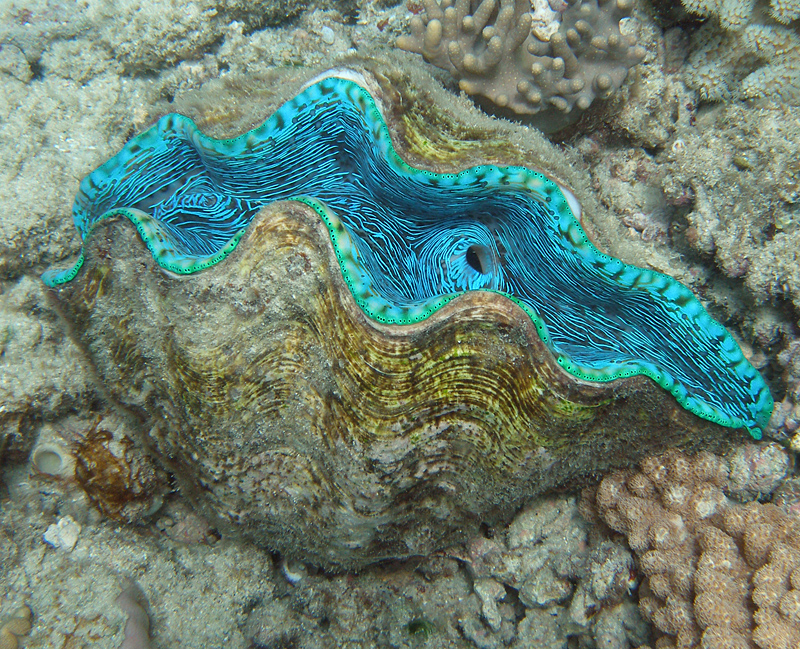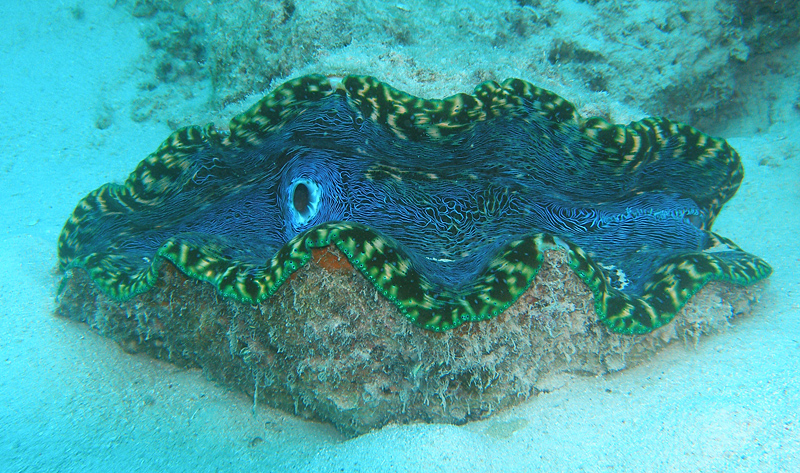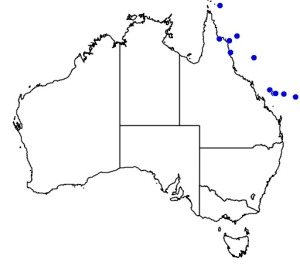
©Andy: An adult Tridacna derasa in the blue colouration at Big Viki's Reef, showing the assymmetrical shell valves and smooth external surface
Distinguishing features
The second largest species of Giant Clam, this species has assymmetrical shell valves and a smooth outer surface to the shell. The animal is attached to the benthos by the byssal threads when small, however it does not embed in the substratum like T. crocea and T. maxima. Large specimens are not attached. Mantle colour is variable, although not to the same extent as the smaller species of Tridacna. Specimens are either marked with numerous thin light blue lines, or else present with a green to brown mantle. The mantle extends over the edge of the shell when fully extended. Distinguish from other species of Tridacna by the smooth shell and colouration patterns.
Size
- Up to 60 cm (Length of specimen)
Synonyms
Comments
A giant Clam can live to about 70 years old. They do not always reach this age however, some are simply overgrown by coral, some are smothered by sediments in a storm. Someone told me that they saw blacktip reef sharks tearing the flesh out of a giant clam. Some clams just fall over. We had one growing on top of a coral head that we called Pete. I am not sure why, but one day it fell over and rolled down the side flattening everything in its wake.
This one had a plate coral grow on it that one day became too heavy and tipped the clam over.
by David Witherall
Distribution
Distribution and habitat preferences
Found in most habitats, but most abundant in shallow, sheltered lagoonal and reef flat habitats.
Found in most shallow habitats around Lizard Island, and extends down to about 6-7m.
Behaviour
Like other Tridacnid clams, this species is a hermaphrodite, with the male testes forming first at about 5 years of age, followed by the female ovaries a year or so later. Tridacnid clams spawn in the warm summer months between October and February, usually during neap tides when water movement is minimal. This allows enough time for adequate mixing of the gametes. Spermatozoa are usually released first, with eggs only released if the animal detects the presence of sperm from a conspecific clam in the water column. Hence, reproduction is most successful when the animals are located in natural clusters. Eggs are only 100µm (1/10th of a mm) in diameter, and several million are released by each clam during a spawning event. Fertilisation is external, and a trochophore larvae hatches after about 12 hours. A bivalved veliger larvae develops after 48 hours, with a shell length of 160µm. This stage feeds on plankton and continues to swim in the water column, although it periodically ventures down to assess the conditions on the benthos. The veliger larvae settle permanently to the substratum at about 9 days of age and about 200µm, and the juvenile clams may reach 20-40mm shell length after their first year. Growth accelerates after this point, however mortality in the first few years is very high, with predation by fishes being a major factor.
Tridacnid clams obtain over 95% of their food requirements from the sugars produced by the symbiotic dinoflagellate algae (zooxanthellae) that inhabit the outer mantle tissue. Juvenile clams acquire the zooxanthellae directly from the water column at the time of settlement, and the algae live in tubules that are tertiary extensions of the gut and extend throughout the mantle tissue. Like hard corals, Tridacnid clams may bleach and lose most of their zooxanthellae after high temperature stress.
Web resources
References
- Clarke, P.J., T. Komatsu, J.D. Bell, F. Lasi, C.P. Oengpepa and J. Leqata (2003). Combined culture of Trochus niloticus and giant clams (Tridacnidae): benefits for restocking and farming, Aquaculture, 215: 123-144.
- Griffiths, D.J., H. Windsor and T. Luong-Van (1992). Iridophores in the mantle of Giant Clams, Australian Journal of Zoology, 40: 319.
- Heana, R.L. and O.J. Cacho (2003). A growth model for giant clams Tridacna crocea and T. derasa. Ecological Modelling 163 (2003) 87–100. Ecological Modelling, 163: 87-100.
- View all references







